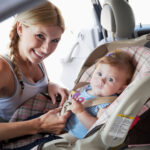News & Events
Car Seat Safety for Children
The best car seat is not always the most expensive one — it’s the one that best fits a child’s weight, size, and age, as well as your vehicle. Once you select a seat, be sure to try it out, keeping in mind that store displays and illustrations might not show the correct usage. It’s up to you to learn how to install a car safety seat properly and harness your child for the ride.
Infant-Only Seats (Birth to 22-35 Pounds)
Infant-only seats fit newborns and smaller infants best, so you will have to buy another seat as your baby outgrows it. Infant-only seats are designed to protect babies from birth until they reach up to 35 pounds (about 16 kilograms), depending on the model.
Infant car seats should always be installed to face the rear of the car. A child under age 2 is 75% less likely to die or be seriously injured when in a rear-facing seat because the back of the safety seat will cradle the baby’s head, neck, and torso in a crash (at this age, a child’s neck usually isn’t strong enough to support the head in a crash).
Convertible Seats
Convertible seats are designed to protect kids from birth up to at least 40 pounds (18 kilograms) facing backward, and up to 65 pounds (30 kilograms) or even 80 pounds (36 kilograms) facing forward, depending on the model.
Convertible seats are the only type of seats that are placed in different positions depending on a child’s age: They face toward the rear until a baby is ready to face forward, when they can be turned around and “converted” to a forward-facing seat.
Forward-Facing-Only Seats (20-80 pounds)
Forward-facing car seats are designed to protect children from 20 to 80 pounds (about 10 to 36 kilograms) or more, depending on the model.
All kids 2 years or older, or those younger than 2 years who have outgrown the rear-facing height or weight limit for their car seat, should use a forward-facing car seat with a full harness for as long as possible. They should only switch to a booster seat that relies on the car’s adult seatbelts when they exceed the height and weight limit for their forward-facing car seat.
The LATCH System
Since September 2002, most new vehicles have safety seat anchorage points and most safety seats have anchor attachments.
One of the problems with installing safety seats properly has been incompatibility between the car seat and the vehicle. The Lower Anchors and Tethers for Children (LATCH) system was devised to make installation easier because it does not require use of the car’s seatbelts.
Air Bags and Kids
Protect your baby or toddler from air bag injury by following these rules:
· Air bags present a serious danger for babies riding in rear-facing car seats. Never place a rear-facing infant seat in the front seat of a car that is equipped with a passenger-side air bag.
· Child safety seats should be placed in the back seat. If you have no choice and must place a child in a car seat in the front (that is, if your car is a two-seater or if the car seat will not fit in the back seat), push the passenger seat as far back as it will go.
Source: http://kidshealth.org/

